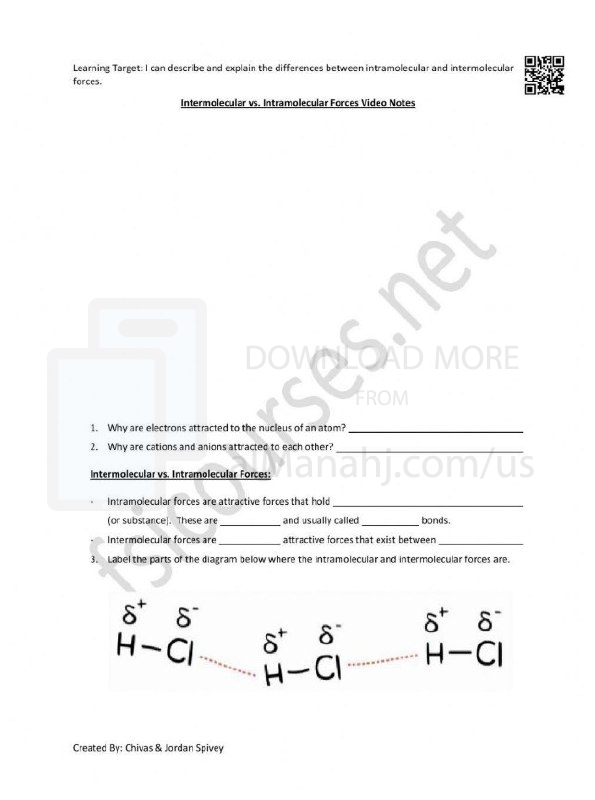| You are here: Almanahj Website ⇒ American curriculum ⇒ 12th Grade ⇒ Chemistry ⇒ Term 1 | ||
|---|---|---|
Worksheet about Intramolecular forces and Intermolecular forces and Ionic bonds and Covalent | ||
|---|---|---|
| Subject: Chemistry | ||
| 12th Grade | ||
| Term 1 | ||
| Year: 2023/2024 | ||
| Size: 250.6KB | ||
| Number of clicks: 323 | ||
| Publish date:November 07, 2023 | ||
| Added by: Eman | ||
| Last download date: 2024-09-11 10:09:10 | ||
| Updated by: Eman9966 on 2023-11-07 08:22:27 | By: theodor Coach Spivey | |
| File info: Intramolecular Forces and Intermolecular Forces: In chemistry, there are two types of forces that exist between molecules: intramolecular forces and intermolecular forces. 1. Intramolecular Forces: Intramolecular forces refer to the forces that hold the atoms within a molecule together. These forces are responsible for the chemical bonding between atoms and determine the structure and properties of individual molecules. The primary types of intramolecular forces are: a. Ionic Bonds: Ionic bonds form between atoms when one or more electrons are transferred from one atom to another, resulting in the formation of oppositely charged ions. The attraction between these ions creates a strong electrostatic force that holds the atoms together. Ionic bonds are typically formed between metals and nonmetals. b. Covalent Bonds: Covalent bonds occur when atoms share one or more pairs of electrons. This sharing of electrons creates a strong bond that holds the atoms together. Covalent bonds are commonly formed between nonmetal atoms, although there are instances where covalent bonds can form between a metal and a nonmetal. c. Metallic Bonds: Metallic bonds are specific to metals and occur when metal atoms share a "sea" of delocalized electrons. This sharing of electrons allows metals to exhibit unique properties such as high electrical conductivity and malleability. 2. Intermolecular Forces: Intermolecular forces are the forces of attraction that exist between different molecules. These forces are relatively weaker than intramolecular forces. The primary types of intermolecular forces are: a. London Dispersion Forces: London dispersion forces, also known as Van der Waals forces, are the weakest intermolecular forces. They occur due to temporary fluctuations in electron distribution, which create temporary dipoles in molecules. These temporary dipoles induce similar dipoles in neighboring molecules, leading to attractive forces between them. b. Dipole-Dipole Interactions: Dipole-dipole interactions occur between polar molecules. Polar molecules have an uneven distribution of electron density, creating a positive end (pole) and a negative end (pole) within the molecule. The positive end of one molecule attracts the negative end of another molecule, resulting in dipole-dipole interactions. c. Hydrogen Bonds: Hydrogen bonds are a specific type of dipole-dipole interaction that occurs when a hydrogen atom is bonded to a highly electronegative atom (such as nitrogen, oxygen, or fluorine) and forms a weak bond with another electronegative atom in a neighboring molecule. Hydrogen bonds are stronger than typical dipole-dipole interactions. The strength of intramolecular forces (ionic bonds, covalent bonds) determines the stability and properties of individual molecules, while the strength of intermolecular forces (London dispersion forces, dipole-dipole interactions, hydrogen bonds) influences the physical properties, such as boiling point, melting point, and solubility, of substances. It's important to note that these forces exist on a continuum, with ionic and covalent bonds representing the strongest forces, while intermolecular forces are relatively weaker. | ||
| Downloading link Worksheet about Intramolecular forces and Intermolecular forces and Ionic bonds and Covalent |
|---|
|
1699345302.pdf
The file is being prepared for download
|
| File images |
|---|
 |